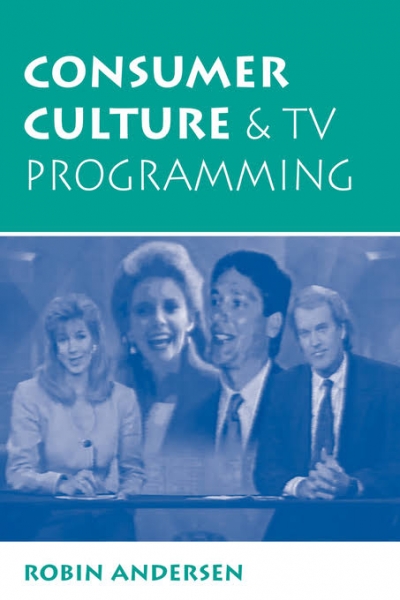



 Yusuf Progler
Yusuf Progler
CONSUMER CULTURE & TV PROGRAMMING By Robin Anderson. Westview Press: Boulder, CO, US. 1995. Pp.306. Pbk: US$17.95.
In 1922, an American farmer and electronics tinkerer by the name of Philo T Farnsworth invented a scanning device that would lead to the development of television. Farnsworth’s ‘image dissector’ solved many of the problems faced by European and American technicians who sought a way to electronically transmit images. Control of Farnsworth’s invention would determine the success or failure of all television development.
In 1939, Farnsworth licensed his device to American media mogul David Sarnoff of RCA. At the time, TV was a novelty but by the late-1950s it had grown into a powerful mass media. When later asked what, he thought about how his invention had progressed, Farnsworth, who died in obscurity in 1971, said he refused to watch TV and expressed disgust at its crass commercialization and the manipulation of the medium by the advertising industry. During Fransworth’s lifetime, creeping commercialization came to infect every aspect of TV, and consumerism had become a way of life for most Americans.
Robin Anderson, associate professor of communications at Fordham University in New York City, examines this phenomenon in Consumer Culture & TV Programming, part of a series from Westview Press on Critical Studies in Communication and in the Cultural Industries. She addresses timely questions about the extent to which the advertising industry controls television, and the cultural environment that allows corporations to shape public perception.
Anderson sums up a key dimension of the relationship she seeks to reveal: ‘It is to say... that in selling commercial time to advertisers to sell products, broadcasters are also selling a product - their audiences.’ In other words, in the world of TV broadcasting, the product is you. By way of sophisticated marketing surveys, advertisers and broadcasters profile audiences which are then targeted with specifically designed campaigns. These profiles are bought and sold like any other commodity in the American cultural industries, except that most Americans do not realize that their eyeballs are being traded for high profits.
In the first three chapters, Anderson provides some necessary background on the broadcasting and advertising industries. Especially useful is chapter Three, ‘Emotional Ties That Bind: Focus Groups, Psychoanalysis, and Consumer Culture.’ Anderson uncovers an army of smug technocrats with PhDs in psychology who are mobilized by the advertising and broadcast industries to define, profile, segment and target audiences according to viewing and consuming habits. Much of this process is quite guileful and it is a wonder that Americans are not out in the streets to protest the way they are manipulated by advertising, whether to sell deodorant or the latest political figurehead.
In developing a general model of advertising discourse, Anderson looks at several product campaigns. For example, an ad campaign for a male baldness treatment ‘evokes feelings of regret, anxiety, and frustration by depiciting an unpleasant childhood memory’ and then ‘promises relief from such long-held disappointments’ by offering the product as a form of ‘psychic healing.’ She concludes that this ‘pseudotherapeutic discourse, common to many advertisements, promises emotional comfort through the use of products that are inherently incapable of providing such comfort.’
In the view of TV advertisers, Americans appear to be a miserable lot, suffering from baldness, bad breath, body odor, obesity, indigestion, headaches, and hemorrhoids, and also from a host of emotional anxieties and psychological disorders, for which a vast array of products is offered as relief. But as Anderson notes, ‘the product and its functional qualities are irrelevant.’ It is the linkages that are important: ‘Keying into psychic desires, needs, frustrations, and anxieties, and then tying those feelings to products, has become the strategy of choice for an industry always searching for the most effective mode of persuasion.’
Ongoing marketing research in the 1980s has developed the ‘soft sell’ as the preferred mode of persuasion for advertisers whose products would otherwise be virtually indistinguishable. Anderson exposes the specialists working behind the scenes: ‘Anthropologists and psychologists employed by ad agencies spend hundreds of hours probing their subject to determine the hidden desires that motivate behaviour.’ For example, researchers at Saatchi & Saatchi, one of the largest American advertising firms, ‘strive to find ways to connect cigarettes with relaxation and to associate fast food with a feeling of safety.’ Such insidious connections are standard fare.
Although her generally materialist analysis overlooks the spiritual dimensions of culture, Anderson suggests that the ‘lack of resources and of meaningful mental health care has left a void in American life. And many people have no means of learning the discursive and emotional strategies necessary to achieve emotional and personal fulfillment. It is no wonder that, given the great need for psychological assistance but with so few providers of those services to the general public, the media in the 1980s became the main forum for expressing such needs. The discourse of therapy is now particularly pervasive on television, where talk shows, dramatic series, and advertising language have capitalized on human dissatisfaction and picked up the mantle dropped by the therapeutic profession.’ And so products become therapy pills.
Subsequent chapters cover specific instances of programming content geared toward selling products. Of particular interest is the fairly recent phenomenon of ‘product placement.’ Not satisfied to simply interrupt programmes with advertising spots, sponsors sought ways to weave products into plot lines. A vast middle-man industry has emerged that previews television scripts for potential product references, and solicits advertisers to pay for having their products featured. When a TV star drinks a particular brand of soda, or munches on a certain kind of cereal, this is no accident. Each product appearing in a programme is there because of sophisticated negotiations and careful planning.
While junk food and trendy items turn up in sitcoms, the scripts for dramatic programmes frequently sell hi-tech products, such as cellular phones and automobiles. Again, this is absolutely insidious and done with the utmost care to convince consumers that product placement simply makes programming more true to ‘real life.’ But avid television viewers seem unable to distinguish between real life and fantasy, and the advertising industries in cahoots with broadcasters have constructed this public perception.
In addition to product placement, advertising intervenes in programming in more subtle ways. It is important to sponsors that programmes provide the ‘proper atmosphere’ for their product messages. One keystone of the consumer edifice is the notion that all problems are individual in nature, and therefore subject to individual choices and remedies. Individualism is absolutely necessary for the survival of a consumer-based society. But this is a false sense of individuality. The contradictory message is to be yourself and buy this product like millions of others who also want to express their individuality through mass consumption. Personal identity is intertwined with product consciousness to such a degree that American youths pay for the ‘privilege’ of wearing logos on their clothing as a marker of personal style.
Another advertising mainstay is a phony sense of ‘family values.’ Anderson suggests that ‘for American culture, as everyday life is ruptured from the political context, the family has become the site of struggle for meaning that embodies all the contradictions of the discourse of persuasion. Presented as utopian fantasy, it is simultaneously the source of all dysfunction. Even if pleasure is to be found within its confines in the present, family structures of the past are responsible for our dysfunction... As the flashpoint of our culture, family life backs us into a corner, trapping us in a search for happiness within a fantasy built from fragments of the shattered dreams of our childhood.’
These shattered dreams are exploited by talk shows. In a chapter on ‘The Television Talk Show: From Democratic Potential to Pseudotherapy’, Anderson shows that any potential for contributing to meaningful public discourse is lost in the rush for ratings and ad revenues. Initially conceived for stars and celebrities to hawk their latest media wares, talk shows in the 1980s and 1990s also became forums for people to reveal their personal tragedies disconnnected from social, political or economic realities.
In the final analysis, as Anderson articulates, ‘talk shows - like advertising and entertainment programming - address real needs but do not fulfill those needs. Talk shows respond to the need for a public forum on issues of common concern, but, like traditional news formats, they fail to connect personal experience with the larger socioeconomic context. Therefore, they cannot help individuals understand their own lives in relation to the social, political, and economic forces that shape them. The TV therapist has come to replace the expert (or political official) as the voice of wisdom. Talk shows speak with a therapeutic language that examines only a privatized landscape of human experience, further rupturing individual needs from collective solutions. Instead of understanding and knowledge, television talk offers its viewers the voyeuristic pleasure of gazing into the private lives of society’s victims. In essence, television’s therapeutic discourse prevents the public from understanding social issues and participating in the answers to social problems.’
After chapters on ‘Reality-based Police Shows,’ ‘Privacy and the Culture of Surveillance,’ and ‘Advertising the Persian Gulf War,’ Anderson returns to the talk show format and its relationship to the 1992 US presidential elections. The same problems with the therapeutic format persist: ‘The discourse of TV therapy is now so pervasive that it penetrates the formulation and definition of public problems. And politicians have learned to stay within its parameters. For instance, the amount of time taken up with the talk-show testimonial style left Clinton no time to answer the question about drugs in broader political terms. In effect, the talk show strategy allowed him to avoid relating the problem of drugs either to social or economic issues such as unemployment, poverty, and rage or to substantive policy proposals.’
Consumer Culture & TV Programming is engaging and provocative. Readers will no doubt enjoy Anderson’s discussion of programming content, but the real value of her work is in identifying the therapeutic nature of television in a dysfunctional society. This is the link between advertising and programming. They are intertwined in ways that insure big profits for corporations while preventing meaningful public discourse.
TV and consumer culture work together to ease the burdens of living in a consumer society and a pseudo-democracy, while simultaneously contributing to and perpetuating the severe social, political, cultural, and economic problems that plague modern American civilization. For that reason alone, this book should be essential reading for Islamic scholars, activists, and believers alike, particularly those living in areas where American-style TV programming is pervasive.
Anderson also provides insights which can inform decisions that many Muslim organizations face regarding the role of television in their social and political activities. Discussions of television that focus only on using it for da’wah or avoiding morally questionable programming content miss the real dangers of TV. While sex and violence are pervasive, simply avoiding these programmes is not enough to escape the effects of TV in a modern capitalist democracy.
TV acts as a sort of Satanic model that constructs a framework for (mis) understanding problems, duties, behaviours and opinions. This volume can help concerned Muslims avoid the self-deceptive ruse of taking the discursive conventions of American television at face value.
Muslimedia: July 16-31, 1997
